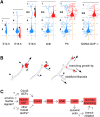Regulation of dendritic branching by Cdc42 GAPs
- PMID: 22855828
- PMCID: PMC3418583
- DOI: 10.1101/gad.199034.112
Regulation of dendritic branching by Cdc42 GAPs
Abstract
Nerve cells form elaborate, highly branched dendritic trees that are optimized for the receipt of synaptic signals. Recent work published in this issue of Genes & Development by Rosario and colleagues (pp. 1743-1757) shows that a Cdc42-specific GTPase-activating protein (NOMA-GAP) regulates the branching of dendrites by neurons in the top layers of the mouse cortex. The results raise interesting questions regarding the specification of arbors in different cortical layers and the mechanisms of dendrite branching.
Figures

Comment on
-
Neocortical dendritic complexity is controlled during development by NOMA-GAP-dependent inhibition of Cdc42 and activation of cofilin.Genes Dev. 2012 Aug 1;26(15):1743-57. doi: 10.1101/gad.191593.112. Epub 2012 Jul 18. Genes Dev. 2012. PMID: 22810622 Free PMC article.
References
-
- Arber S, Barbayannis FA, Hanser H, Schneider C, Stanyon CA, Bernard O, Caroni P 1998. Regulation of actin dynamics through phosphorylation of cofilin by LIM-kinase. Nature 393: 805–809 - PubMed
-
- Arnaud L, Ballif BA, Forster E, Cooper JA 2003. Fyn tyrosine kinase is a critical regulator of Disabled-1 during brain development. Curr Biol 13: 9–17 - PubMed
-
- Ayala R, Shu T, Tsai LH 2007. Trekking across the brain: The journey of neuronal migration. Cell 128: 29–43 - PubMed
Publication types
MeSH terms
Substances
Grants and funding
LinkOut - more resources
Full Text Sources
Miscellaneous
